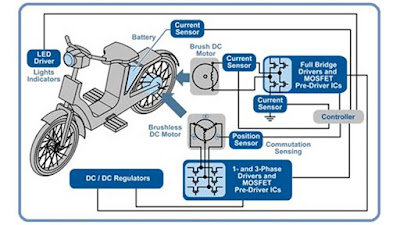Here's the video link for those who do not like reading:
Introduction:
Battery Pack:
The battery pack is the primary energy source for electric vehicles. Comprising numerous individual cells, it stores electrical energy and provides power to the electric motor. Lithium-ion batteries, known for their high energy density and rechargeability, are commonly used in modern EVs. The battery pack also incorporates a management system to monitor cell health, regulate temperature, and control charging and discharging processes.Electric Motor:
The electric motor is responsible for converting electrical energy from the battery into mechanical energy to drive the vehicle. There are different types of electric motors, including AC induction motors, permanent magnet motors, and synchronous reluctance motors. The motor control unit regulates the motor's speed, torque, and overall performance.Power Electronics:
Power electronics play a crucial role in managing the flow of electrical energy between the battery, electric motor, and other vehicle components. The power electronics system includes an inverter that converts direct current (DC) from the battery into alternating current (AC) for the motor. It also controls the voltage, current, and frequency of the power supplied to the motor.Onboard Charger:
The onboard charger is responsible for converting alternating current (AC) from the electrical grid into direct current (DC) to charge the battery. It ensures efficient and safe charging by regulating the voltage and current levels. Some advanced EVs also incorporate bidirectional charging capabilities, allowing the vehicle to supply power back to the grid (vehicle-to-grid technology).Thermal Management System:
Efficient thermal management is crucial for maintaining optimal performance and longevity of the EV's components. The thermal management system regulates the temperature of the battery pack, power electronics, and electric motor to prevent overheating and ensure efficient operation. It may include cooling systems such as liquid cooling or air cooling, along with sensors and control algorithms to maintain the ideal operating temperature range.Auxiliary Systems:
Electric vehicles incorporate various auxiliary systems to provide comfort, convenience, and safety features. These include heating, ventilation, and air conditioning (HVAC) systems, power steering, braking systems (often equipped with regenerative braking to recover energy), infotainment systems, advanced driver-assistance systems (ADAS), and more. These systems are powered by the vehicle's high-voltage electrical system.Communication and Control:
To ensure seamless operation and integration of various vehicle systems, electric vehicles employ a sophisticated network of communication and control modules. These modules facilitate real-time communication between the battery management system, motor control unit, power electronics, and other subsystems. They also enable data exchange with external interfaces, such as charging stations or connected infrastructure.Conclusion:
The electric vehicle system architecture represents the backbone of the modern electric transportation revolution. It seamlessly integrates various components, including the battery pack, electric motor, power electronics, thermal management system, auxiliary systems, and communication modules. This intricate interplay of technologies enables the efficient conversion, storage, and utilization of electrical energy, delivering a sustainable and exhilarating driving experience. As research and development continue to advance, the electric vehicle system architecture will evolve, unlocking new possibilities and pushing the boundaries of transportation innovation.
What's in it for you?
The total cost of ownership (TCO) of an electric vehicle (EV) encompasses more than just the upfront purchase price. It takes into account various factors, including acquisition costs, operating costs, maintenance expenses, and potential incentives. Here are the key components to consider when calculating the TCO of an electric vehicle:Purchase Price:
The purchase price of an electric vehicle is typically higher than that of a conventional gasoline-powered vehicle. However, the price difference has been decreasing over the years due to advancements in technology and economies of scale. It's essential to compare the upfront costs of different EV models to determine their impact on the TCO.
Charging Infrastructure:
Installing a home charging station or utilizing public charging stations may involve additional costs. These costs can vary depending on the charging equipment, installation requirements, and local electricity rates. It's important to consider the availability and accessibility of charging infrastructure in your area when assessing the TCO.
Fuel and Energy Costs:
One of the significant advantages of EVs is their lower fuel and energy costs compared to gasoline or diesel-powered vehicles. Charging an EV typically costs less per mile traveled than refueling a conventional vehicle. The exact savings will depend on the local electricity rates and driving patterns. Analyzing the average energy consumption of the EV and comparing it to the cost of gasoline or diesel is crucial for estimating long-term savings.
Maintenance and Repairs:
Electric vehicles generally have fewer moving parts and simpler drivetrains compared to internal combustion engine (ICE) vehicles. As a result, they may require less maintenance and have lower repair costs. EVs do not need oil changes, have fewer components subject to wear, and regenerative braking can extend the life of brake pads. However, it's worth considering that EV-specific components, such as batteries, may require replacement after a certain number of years or miles, which can impact the TCO.
Incentives and Tax Credits:
Various governments, municipalities, and utility companies offer incentives and tax credits to promote the adoption of electric vehicles. These incentives can significantly reduce the upfront costs or provide ongoing benefits, such as reduced charging rates or tax deductions. Researching and taking advantage of applicable incentives can have a substantial impact on the TCO of an electric vehicle.
Resale Value:
Resale value is another aspect to consider when evaluating the TCO of an EV. Although electric vehicle technology is rapidly advancing, and new models with improved features are introduced regularly, the resale value of EVs has generally been competitive. Factors such as battery health, model popularity, and market demand can influence the resale value.
It's important to note that the TCO of an electric vehicle can vary significantly depending on individual circumstances, including driving habits, local incentives, electricity rates, and maintenance requirements. Conducting a comprehensive analysis and comparing the TCO of electric and conventional vehicles specific to your situation will provide a more accurate estimation of the cost savings and benefits associated with electric vehicle ownership.












